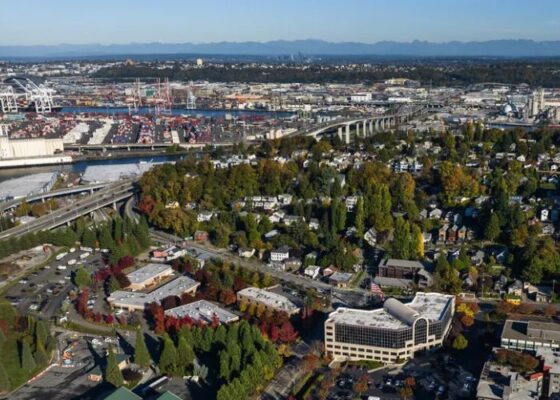The price of the long-awaited West Seattle light rail extension project went up to a huge $6 billion. This will finally connect the peninsula neighborhood to downtown Seattle and the rest of the region’s growing transit network. Read below about “West Seattle Light Rail Costs Surge- Why the Price Tag Hit $6 Billion”.
As a transportation writer, I’ve been following the story of bringing rail transit to West Seattle for years, so this huge cost increase didn’t come as a big surprise. The budgets for big projects like this often go up over time because of things like technical problems, rising prices, and other things that planners didn’t expect. However, the most recent 67% increase over earlier predictions has caused a stir and brought up the question of whether the project’s benefits are worth the huge costs.
There are a lot of reasons why the West Seattle light rail extension has become so expensive. I’ll explain them in this piece, along with what this might mean for the project’s future. As someone who has covered transit problems in the Puget Sound region for seven years, I’ll give you some background on how hard it is to build rail in crowded cities and talk about some of the tough choices that transportation officials have to make right now.
Table of Contents
Why Costs Increased
The West Seattle extension is a 4.7-mile route that will connect the Alaska Junction neighborhood in West Seattle to downtown Seattle and the airport in about 14 minutes. It will work as a branch off of the current Link light rail system. A lot of tunneling and elevated guideways will be needed for the project to get through the steep terrain and crowded areas along the alignment.
Sound Transit, which is in charge of the project, says that the need to build a second downtown transit tunnel to fit the extra trains from West Seattle was a big reason why the costs went up. At first, planners thought they could use the 1.3-mile Downtown Seattle Transit Tunnel, which opened in 1990. But studies showed that once the line opened, the tunnel would be full and would need a whole new, parallel tube to make room for future growth. This second tube alone will cost a lot more money—$700 million.
Costs went up a lot because of inflation and problems with the supply chain caused by the COVID-19 outbreak. As the economy got better, the prices of important building products like steel and concrete went up a lot more than expected. Because there aren’t enough skilled building workers to meet the high demand, labor costs also went up.
The difficult terrain and environment along the path also made it more expensive. The line needs to go through tunnels for 3.5 miles, including one right under the Duwamish Waterway. Building tunnels is a very difficult and expensive job, especially when it has to be done under water. In other parts, tracks and stops are built up to 115 feet above the ground, which is also an expensive project. Technical studies showed that the foundations and retaining walls needed to be bigger than expected in order to support the buildings properly in places where the ground isn’t stable.
A lot of smaller changes added up over time in addition to these big ones. Costs have gone up by 67% since 2016, due to changes in station designs, more stormwater infrastructure, better power systems, and inflation.
What This Means for the Project
The new price tag of $6 billion makes people worry about how affordable it will be and whether the costs will go up, but Sound Transit is still determined to build the West Seattle line. The area needs to add more high-capacity transit right away to keep up with the growing population and traffic. And people in West Seattle have waited decades for rail service and have voted more than once to raise taxes to make it happen.
But the rising costs mean that some tough choices need to be made. Sound Transit needs an extra $1 billion to build the line the way it is planned now. They are likely to put off other projects for a year or more to help close the gap. The board also recently agreed to put a $500 million fee on the November ballot, which means voters would have to agree to it. There are also choices to cut back on the project, apply for federal grants, or push back the opening date even further from the current goal of 2032.
Because I’ve seen for myself how badly West Seattle needs better public transportation through my work, I hope that everyone in the area can work together to pay for the whole thing. But I also get why people are worried about how much things are costing. Budgets for big projects like this often go up, but a 67% rise in just six years makes me wonder about the planning and figures that were used at the start.
It is clear that Sound Transit and its partners need to think carefully about why costs went up so much and how they can better control them in the future. Uncertainties exist in all projects, but when costs keep going up, the public loses a lot of faith in them. Officials need to be honest about what went wrong, show that they’ve learned from their mistakes, and explain how they’re putting in place better rules.
Future megaprojects will also need more backup plans and the ability to change course quickly when problems arise. And having outside experts keep an eye on things could help confirm the first cost estimates.
But I can see why people might be shocked by the cost of huge, difficult projects like digging under downtown Seattle and the Duwamish. We can’t expect years from now to be completely accurate. I’m still sure that finally getting light rail to West Seattle will be well worth the money as long as leaders use what they’ve learned here.
The Way Ahead
The path to building the West Seattle extension has been rough at times, but I’m still hopeful that Sound Transit can complete this game-changing project without any major new delays. The office has a strong history of completing large projects successfully, such as the U-Link and Northgate extensions. West Seattle could be the hardest project so far, but the area has shown it is willing to put in a lot of work to get these important lines built.
I know how important it is to give West Seattle residents the transportation options they deserve because I’m a reporter who has seen how new light rail lines change neighborhoods. This project is still very important for the region’s climate and transportation goals.
Yes, agencies do need to face tough questions about the rising costs and learn from their mistakes. But we shouldn’t let the growing pains of building transit stop us from moving forward. By being honest and careful with public money, I think West Seattle will finally get the world-class transit it has been waiting for so long. The trip is still worth it in the end. Hope you understand “West Seattle Light Rail Costs Surge- Why the Price Tag Hit $6 Billion”.
Michaela Krajanova is an expert in travel journalism and blogging. With over 10 years of experience and a Master’s degree in Hospitality Management, Michaela Krajanova has cultivated a substantial following on Instagram, showcasing her travel photography and insights. Explore engaging travel guides and stories on her Instagram handle @michaela_krajanova, where she connects with a vibrant community of travel enthusiasts. Michaela’s work makes travel accessible and inspiring for readers around the globe, providing firsthand experiences and expert advice.





